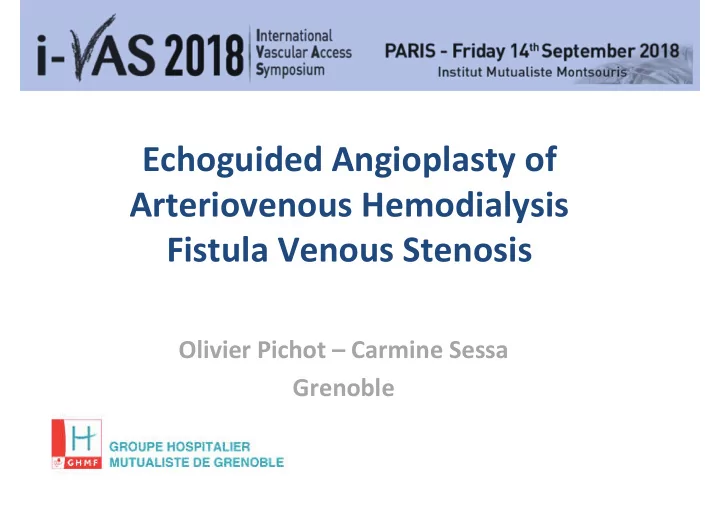

Echoguided Angioplasty of Arteriovenous Hemodialysis Fistula Venous Stenosis Olivier Pichot – Carmine Sessa Grenoble
Systematic echo guidance – Distal veins Fluoroscopic guidance – Cephalic arch – Central v.
AVF DU analysis – Brachial flow, RI – Stenosis characterization : • PSV, • Diameter, localization, type Mapping 3
Choice of the vascular access site Preoperative DU and PTA management: (Doelman 2005 ) Preoperative DU and PTA management: (Doelman 2005 ) • Optimize the choice of the cannulation site in 38% of cases • Optimize the choice of the cannulation site in 38% of cases • Reduce the number of access punctures • Reduce the number of access punctures • Avoid extra session to perform PTA and shorten examination time • Avoid extra session to perform PTA and shorten examination time • Avoid extra burden for the patient • Avoid extra burden for the patient Choice of the appropriate balloon • Length & diameter • Type: • Regular • Coated • High pressure • Cutting 4
« Surgery like » set-up
Sterilized supplies
Sterilized supplies
1. Venous (or arterial) access 2. Introducer tip positioning 3. Guide wire catheterization of the vein (and/or of the artery and anastomosis) 4. Balloon positioning 5. Balloon inflation 6. Angioplasty result analysis: – Stenosis release – Hemodynamic result (local, access flow) – Complication
1.Vascular access Non systematic EG Mandatory (very useful) – Drainage vein • Maturation delay • Retrograde catheterization • Obesity – Brachial artery • Radial or ulnar artery PA 9
Mandatory (very useful) EG if: – Short distance between the vein access site & the stenosis 2 cm 10
3. Catheterization
4. Balloon positioning
4. Balloon positioning
5. Balloon inflation
6. Result evaluation
Retrospective study – January 2016 to June 2018 – PTA of any stenosis in any AVF Echo guided PTA – Success criteria • Velocity normalization : – No aliasing – PSV < 3m/s • No anatomical residual stenosis – Vein diameter normalization /adjacent venous segment – Diameter ≥ 5 mm Fluoroscopic guidance – Success criteria • No anatomical residual stenosis (>50%) • No residual collateral vein visualization
Complications – Cephalic v. rupture 2.4 % (n=) 2
Complications – Perivenous hematoma 2.4 % (n=) 2
Complications – Extended dissection 21.7 % (n=) 18 • Successful prolonged compression 19.3 % 16 • Residual stenosis 2.4 % 2
Patients Access PTA Technical Complications (n) succes Baccini Graft 12 0 9 100% 2000 Stent (2) Napoli AVF 7 0 7 100% artery 2007 Stent (2) Ascher 25 AVF vein 32 100% 1 rupture 2009 1 dissection Fox 125 AVF 223 98% 2 hematoma / 6 false aneurysm 2011 Graft Stent (5) 8 endoluminal thrombosis / 3 ruptures Gorin 30 AVF vein 55 93% 2 catheterization failure 2012 4 hematoma including 3 thrombosis Gallagher AVF vein 185 1 rupture 45 95.5% 2012 total N = 241 N = 514 93-100% n = 31 (6%) 24
Avoids the risk linked to radiation exposure – Patients – Medical team Avoids the risk linked to contrast agent using – Allergy – Néphrotoxicity Reduction of the duration of the procedure Reduction of the cost 25
“In office” practice Fox D et al. Duplex guided dialysis access interventions can be performed safely in the office setting: techniques and early results. Eur J Vasc Endovasc Surg. 2011
Security and accuracy of the vascular access Real time monitoring of all the procedure steps Vein and/or catheter mobilization maneuver Real time assessment of the procedure outcome – Anatomical – Hemodynamic +++ – Immediate and postponed (recoil) 27
A valuable alternative to fluoroscopy for upper limbs veins PTA (cephalic & basilic veins) Allows a precise and continuous monitoring of all the steps of the angioplasty Provide anatomical and hemodynamic data Avoid X rays and contrast Save time (and money!) But requires ultrasound skill… and accepting to change your fluoroscopic usual references! 28
Recommend
More recommend